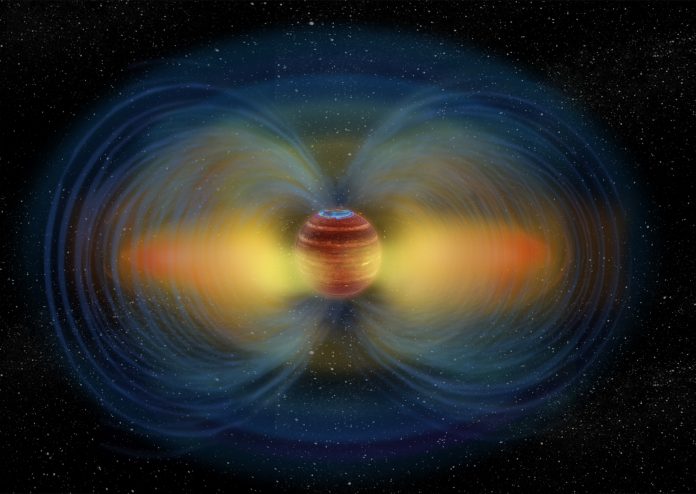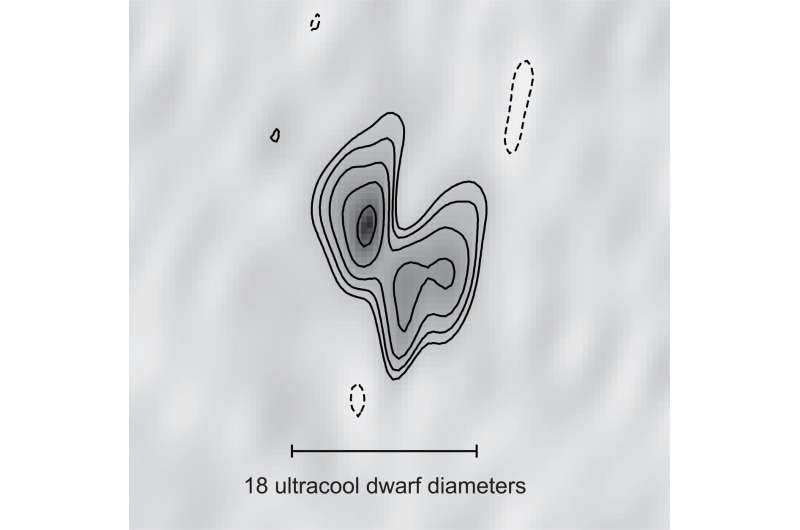
A double-lobed structure like the radiation belt of Jupiter has been spotted using high-resolution emissions from an ultracool dwarf
Using an array of 39 radio dishes ranging between Hawaii and Germany to obtain ultra high resolution images, researchers have been able to describe the first radiation belt observed outside our solar system.
“By combining radio dishes from across the world, we can make incredibly high-resolution images to see things no one has ever seen before. Our image is comparable to reading the top row of an eye chart in California while standing in Washington, D.C.,” said coauthor Jackie Villadsen at Bucknell University.
Imaging the magnetosphere
“We are actually imaging the magnetosphere of our target by observing the radio-emitting plasma – its radiation belt – in the magnetosphere.
“That has never been done before for something the size of a gas giant planet outside of our solar system,” said Melodie Kao, a postdoctoral fellow at UC Santa Cruz and first author.
According to the team, the images have revealed persistent, intense radio emissions from an ultracool dwarf.
These emissions reveal the presence of a cloud of high-energy electrons trapped in the object’s powerful magnetic field, forming a double-lobed structure analogous to radio images of Jupiter’s radiation belts.
A magnetic bubble: Earth, Jupiter and trapped particles
Very strong magnetic fields result in the formation of what is known as a “magnetic bubble” or a “Magnetosphere”. These bubbles can trap and accelerate particles near to the speed of light.
Planets like Earth and Jupiter have these magnetic fields, and so also have radiation bests consisting of these high-energy charged particles trapped by the field.
Most of the particles in Jupiter’s belts are from volcanoes on its moon Io.
If you could compare Jupiter’s belt along with the new discovery from Kao’s team, you would see that Kao and her team’s new image would be 10 million times brighter than Jupiter’s.
The origin of the northern lights
When particles are deflected by the magnetic field towards the poles of a planet, it generates auroras (Northern Lights) when they interact with the atmosphere.
Koa’s team have been able to obtain the first image capable of differentiating between the location of an object’s aurora and its radiation belts outside our solar system.
“This is a critical first step in finding many more such objects and honing our skills to search for smaller and smaller magnetospheres, eventually enabling us to study those of potentially habitable, Earth-size planets,” said co-author Evgenya Shkolnik at Arizona State University, who has been studying the magnetic fields and habitability of planets for many years.
“Auroras can be used to measure the strength of the magnetic field, but not the shape. We designed this experiment to showcase a method for assessing the shapes of magnetic fields on brown dwarfs and eventually exoplanets,” Kao said.
Auroras can be used to measure the strength of the magnetic field, but not the shape
The boundary between low-mass stars and massive brown dwarfs
The ultracool dwarf these images revelaed walks the boundary between low-mass stars and massive brown dwarfs.
“While the formation of stars and planets can be different, the physics inside of them can be very similar in that mushy part of the mass continuum connecting low-mass stars to brown dwarfs and gas giant planets,” Kao explained.
The ultracool dwarf known as LSR J1835+3259 was the only object Kao felt confident would yield the high-quality data needed to resolve its radiation belts.

A theoretical understanding with physical results
Characterizing the strength and shape of the magnetic fields of this class of objects is largely uncharted terrain, Koa explains.
Using a theoretical understanding of these systems and numerical models, planetary scientists can predict the strength and shape of a planet’s magnetic field, but they haven’t had a good way to easily test those predictions.
To generate a magnetic field, a planet’s interior must be hot enough to have electrically conducting fluids.
“Now that we’ve established that this particular kind of steady-state, low-level radio emission traces radiation belts in the large-scale magnetic fields of these objects, when we see that kind of emission from brown dwarfs – and eventually from gas giant exoplanets – we can more confidently say they probably have a big magnetic field, even if our telescope isn’t big enough to see the shape of it,” Kao said.










